Terminating an employee isn’t easy, but it’s a necessary step if they’re having a negative impact on the organization. The reasons for dismissal can vary from poor performance to misconduct and general layoffs, but what’s essential in every situation is a well-structured termination letter.
To ensure you don’t end up in legal battles down the road, the letter needs to be written in a specific way, and it should outline all the details of the termination and what’s to follow.
So, to make sure you’re following the correct protocols, read through our step-by-step guide (complete with handy termination letter samples) to help you write your own employment termination letter.
What is a termination letter?
Not to be confused with a redundancy letter — as the name suggests, a termination letter serves as a formal notice of dismissal to the employee. Although the Fair Labor Standards Act (FLSA) doesn’t require employers to provide written notice of termination, producing a termination letter is a display of professionalism and respect for your team.
Additionally, doing so will allow you to keep an official record of what went on. It’s estimated that 250,000 people are wrongfully dismissed each year, and by writing up a comprehensive termination letter, you’ll ensure that your employee can’t later accuse you of wrongful dismissal. Thus, you’ll want to include specific details in your letter, like the effective date and any previous warnings given.
Structuring your letter
As this is an official document, you must stick to grammatical and formatting rules to ensure that the information is presented in a professional manner.
Your letter should typically contain the following elements.
1. Sender’s address
Your letter should include the company’s address listed in the top left-hand corner of the page, or in the top right-hand corner in US letters. Include the official date that the letter was written beneath the recipient’s address.
2. Recipient’s address
The employee’s address should be listed a few lines underneath the company’s address, aligned to the left of the document.
3. Greeting
As you are already on a first name basis with the employee, it’s fine to address them by their first name, for example: “Dear John”.
4. Opening paragraph
In the opening paragraph, you should first explain that it’s a letter of termination and then supply whether it’s effective immediately or if the employee in question needs to work a specific notice period.
5. Main paragraphs
Within the body of the letter, you should cover everything related to final pay, paid time off, pension, healthcare and anything else that would affect the employee after their termination.
6. Final paragraph
The steps to follow should be listed in the final paragraph. For example, you can ask the employee to return all company property to the HR department (including keys, telephones, laptop and passwords).
The ending of the letter won’t be incredibly positive (how can you really turn a termination into a positive?!), but do make it a point to inform the recipient that you are there in case they have any questions. Alternatively, if you won’t be the one answering further questions, provide the contact information of the manager or supervisor who will.
7. Your name and signature
As you will need a printed copy of this letter, opt for a handwritten signature, and be sure to leave space for the employee’s signature at the bottom of the letter.
Tips for writing your letter
You’ve thought about your reasons for letting an employee go and decided on a date to inform them. However, there are still some things to consider before handing your employee a letter of termination, or even inviting them to your office for a one-on-one chat. These include familiarizing yourself with the legal requirements specific to your state and drafting a clear outline of what’s to follow.
1. Consult your legal team
If you’re unsure about how to handle the termination, what notice to give the employee and whether you should offer a severance package or not, it’s a good idea to consult your legal team before you make a decision. If it’s a layoff, for example, there may be specific regulations that you need to be aware of.
It’s important to avoid wrongful termination, as this can lead to endless legal battles further down the line, and it can have an even bigger effect on your organization. Essentially, you need to ensure the termination is in line with the employment contract and that it is done fairly.
2. Discuss in person beforehand
It’s unfair to advise the employee of their termination without having a verbal conversation beforehand. You need to explain the cause of their dismissal and allow them the opportunity to voice their thoughts and feelings.
3. Include all evidence for the reason of termination
To support your decision for firing the employee, you’ll need to include all evidence to support your claims. For example, if the employee has been on a performance improvement plan (PIP) and has received written warnings, then this moment would have been leading up for a while, and you will have ample evidence to support your decision.
Likewise, if the employee has gone against the employment contract by verbally abusing someone or destroying company property, you are entitled to fire them on the spot. That said, you should supply any evidence of their poor behavior when delivering the termination letter.
4. Verbally describe the steps to follow
Although the process will be described in detail within the termination letter, it’s important to also verbally discuss the steps that will follow. For example, you could instruct the employee to pack up their personal belongings and leave the building as soon as your meeting is over.
You can also explain what will happen with private pension schemes, healthcare and other benefits that the employee was receiving. And, if possible, you could provide a final paycheck or supply instructions on when they will receive their balance.
Termination letter template
Here is a downloadable termination letter template that you can customize for the circumstances relevant to the employee and in your organization.
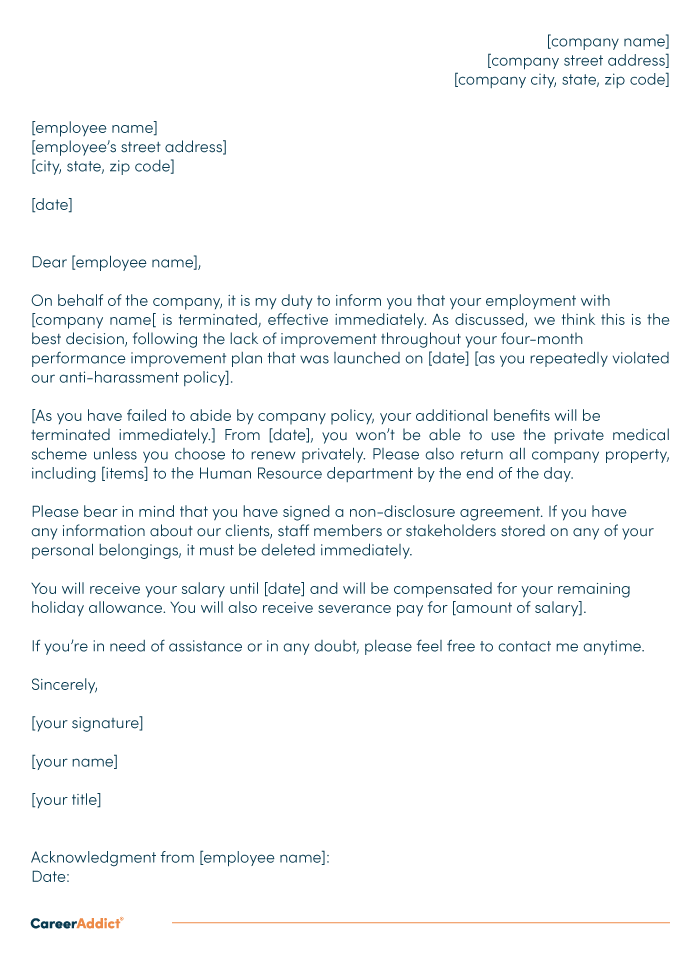
Termination letter examples
Here are a few more examples to give you some inspiration for different circumstances.
Furlough letter example
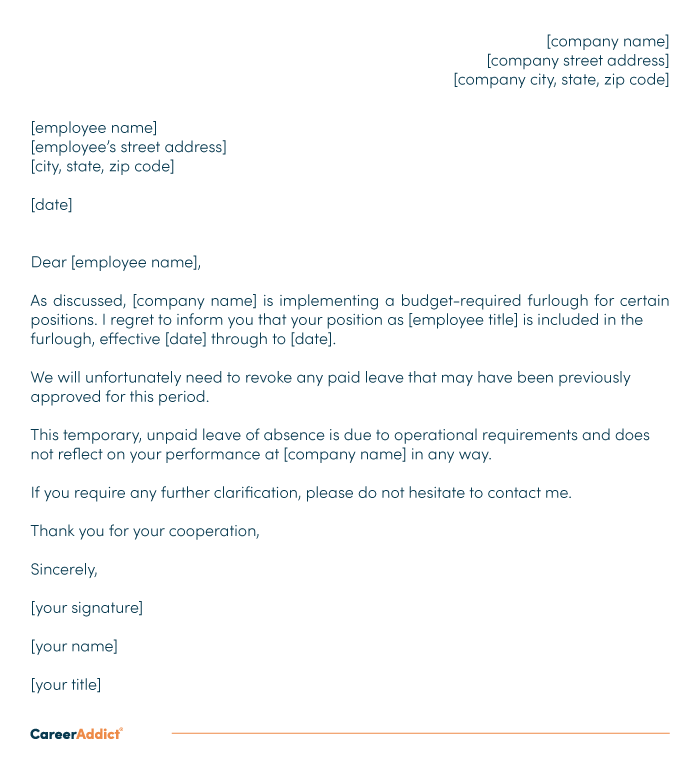
Breach of contract letter example

Layoff letter example
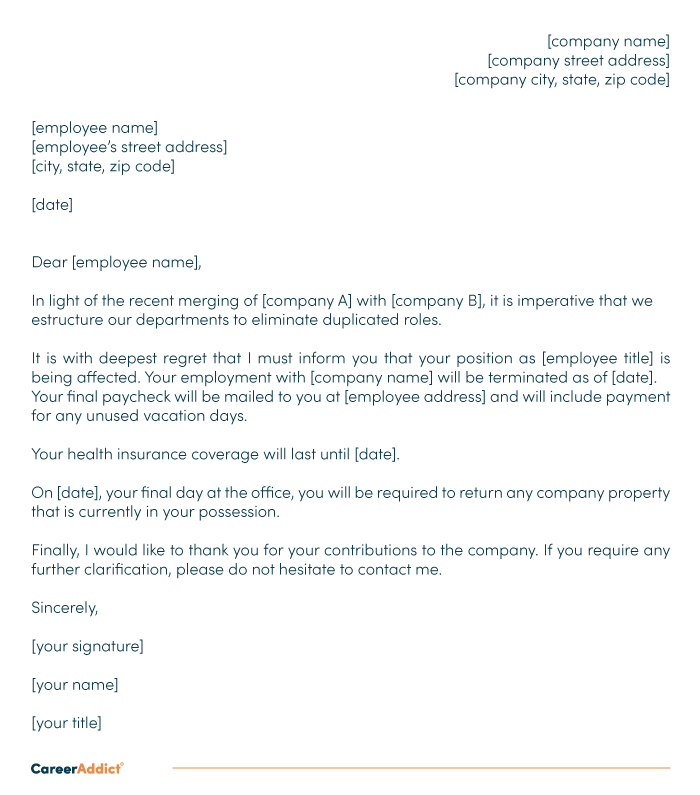
Misconduct letter example
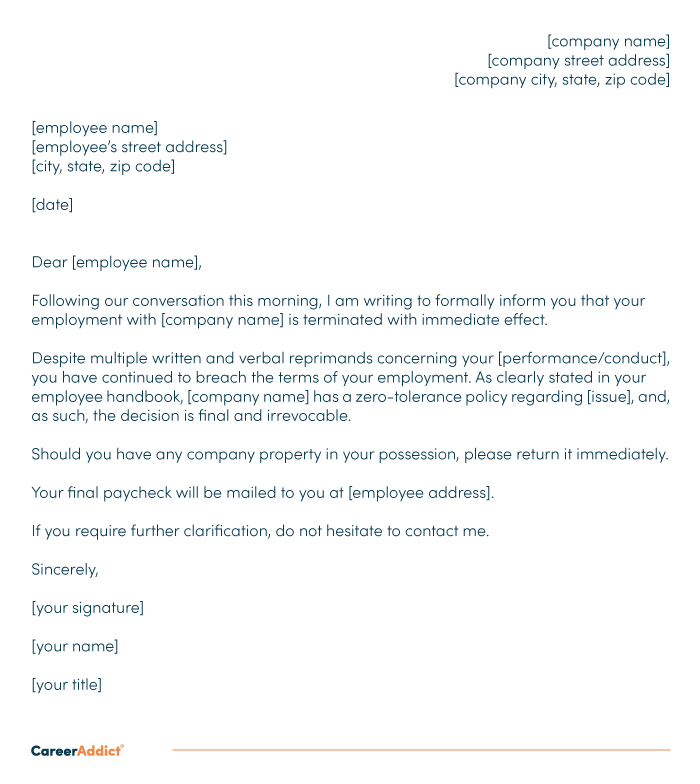
Incompetence letter example
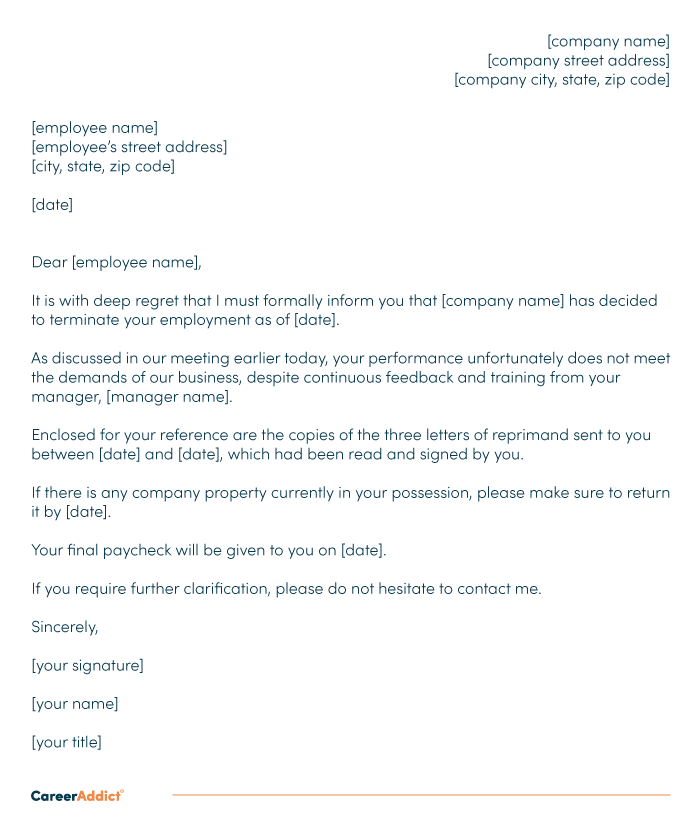
Things to remember
Informing an employee that they’re no longer required can come with its fair share of guilt, even for experienced human resource managers.
However, there are ways to make this process a little less painful, both for yourself and the other party. Below are some good-to-remember tips for you to follow when handing over that official termination letter.
1. Ask the employee to sign the letter
Don’t forget to ask the employee to sign the letter to acknowledge and agree to the terms of their termination. You will then need to place this in the employee’s file as proof of the agreement and save a copy in case you are ever accused of wrongful termination.
2. Place the letter in a sealed envelope
As the letter is confidential, you should place it inside a sealed envelope labeled with the employee’s name and the words “Private and Confidential”. That way, if it happens to end up in the wrong hands, they will know not to open it.
3. Choose an appropriate time
If the employee has gone against company policy, you won’t be able to select your timing. However, if you’ve been planning the termination for a while, you should be mindful of when you hand the letter to the recipient. It’s best to do this fairly close to lunchtime so the employee can make a swift exit if they don’t want to stick around and say goodbye to their colleagues.
Key takeaways
Even in business, it’s important to know when to say goodbye — especially when an employee’s behavior negatively affects others in the working environment.
Though there is no federal law that requires employers to provide formal termination letters, writing them up can be a great way of showcasing consideration for your staff and avoiding ending things in bad blood. When doing so, remember to:
- Arrange a one-on-one meeting first to let your employee know of your intentions. Try not to catch them by surprise, no matter how disappointed you may be.
- Gather up all supporting evidence for your decision, including a copy of any written reprimands given to the employee in the past.
- Explain the next steps clearly, informing your employee about the effective date of termination and what will happen with any benefits.
- Follow the layout of a termination letter sample, like the ones above, if you’re having trouble putting thoughts to words. That will help you write a termination letter that’s succinct and respectful.
It’s never a nice thing to do, but at least with this as a guide, you’ll be confident you’re covering all bases when the time does eventually come.
Did you find this useful? Share this with your fellow HR colleagues, so you’re all on the same page.
This article was originally published back in 2019. Updated by Electra Michaelidou.

